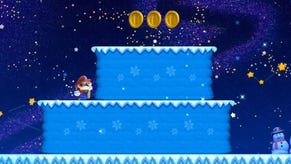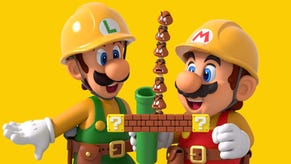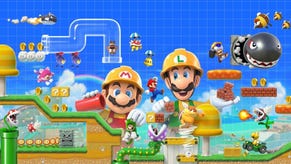The Super Mario Maker Team Speaks on the Game's Update, and the Future
The creators talk about the new material, the prospect of future updates, and what they think about the idea of a Zelda Maker.
This article first appeared on USgamer, a partner publication of VG247. Some content, such as this article, has been migrated to VG247 for posterity after USgamer's closure - but it has not been edited or further vetted by the VG247 team.
USgamer: How has the experience of watching and playing user levels been for you, as the game's creators? Seeing these creations trickle in and really putting the Mario concept through its paces?
Tezuka: As someone who's worked on the Mario series for a long while now, there haven't been that many huge surprises for me. But one thing I've really enjoyed seeing is that there seems to be something for everyone with this game. We've seen a lot of really difficult courses, which are very popular with one set of players. And there have also been a lot of automatic courses that have been really popular with a different set of players. That level of variety has made me happy.
Oh, actually, I can think of one thing that surprised me. I heard that someone made a course, and... you know, in order to upload it, you have to be able to clear it yourself. And just for them to be able to clear it and upload it took them 50 hours. This was something I really hadn't expected!
Oshino: One thing that I was excited to see was there have been more than three million courses uploaded so far. Watching that number rise has been interesting. I was also surprised—in terms of the game skins you can choose—to see how popular the New Super Mario Bros. U skin has been.
Yamashita: Just in terms of the Japanese player base, one thing that took me completely by surprise was a course in which a player created a functioning calculator. That was something I never would have expected! You know, we did anticipate we'd see some of the automatic Mario courses, courses that feature the ability to play music of a sort, or that use the Costume Mario ability in interesting ways. And also courses that we think of as a typical Super Mario Bros. course. But when I saw this calculator that someone made in a Super Mario level, it was almost as if someone had knocked me over from behind.
USgamer: Is there anything you haven't seen in Super Mario Maker whose absence surprises you?
Tezuka: Honestly, with more than three million courses being out there in the wild, we obviously haven't seen them all. I'm sure that there are all kinds of interesting ideas out somewhere out there in those millions of courses. So, for me, I can't think of anything in particular that I haven't seen yet.
That being said, as Mr. Oshino mentioned previously, courses using the New Super Mario Bros. U skin are something we've seen a lot of. But on the other end, it seems like we haven't seen a lot of Super Mario Bros. 3 courses. Also, in terms of course types, we've seen there haven't been many underwater course. So those might be interesting to see people make more use of. Thinking back to the development of the game, we had people uploading test courses, and I remember some pretty interesting underwater courses. So that's something I'd like to see more of—taking on the challenge of making interesting and challenging underwater course.
USgamer: Mr. Tezuka, you mentioned you've been involved with the Mario series for a long time. How does the Super Mario Maker design experience compare to the experience you had with the tools for designing Mario games on NES and Super NES?
Tezuka: In comparing being involved with the development of Super Mario Maker with working on the original Super Mario Bros.... Well, 30 years ago, we definitely had a feeling that we were starting from scratch in a lot of different ways. For example, we really needed to decide on and come up with the work flow that we were going to need in order to create courses for the game. So, for example, if we had an idea, we had to figure out how we would work with the programmers to get those ideas into the game or if it would even be possible. While it wasn't easy back then, we were able to work with all the different members of the team to—for example—have tools created if there was a particular feature we wanted that wasn't yet implemented.
It may be partly from that experience, but one of our aims with Super Mario Maker was to make a game that would make making Mario easy for anyone and, at the same time, show how deep of an experience that can be and allow for creating depth on the part of our course-makers—our players.
That's my point of view as one of the creators of the game. Speaking from the viewpoint of the player, our goal in creating Super Mario Maker was not to force people—or even to encourage people—to make the types of polished courses or well-balanced courses that you see in traditional Super Mario games, but instead to turn over the tools of creation to players and to turn the act of making into a game itself. To give the freedom to the player to basically use the software like a toy.
USgamer: People using Super Mario Maker have 30 years of Mario games to draw on for inspiration, but when you were making the original Super Mario Bros., you didn't have precedent to work again. How did you tell if the levels you were making were good? How did you know these ideas would work?
Tezuka: First, as we were making courses for the original Super Mario Bros., we would make use of the fact that we had a lot of play testers in the staff all around us. As we were making a course, the most important part would be to have lots of people play it. And they would be sure to give their feedback and opinions.
Aside from individual courses, we really did pay a lot of attention to the flow of one stage to the next and the order we put them in. That was something we spent a lot of time trying to get right.
In terms of inspiration for the original Super Mario Bros... like you mentioned, we didn't have a lot of other platforming game examples to drawn on. Really, I'd say the biggest inspiration came from Mr. Miyamoto's conviction in wanting to make a game that expanded the bounds of what Mario games had been up until that point. You're probably familiar with Mario Bros., which preceded Super Mario Bros., where the action took place in a confined space on a single screen. Mr. Miyamoto really believed in wanting to make a game that would allow you to run and scroll the screen. With that idea, we set out to find out what kind of action would feel good to the player in that kind of game.
Another thing we wanted to include was the idea that the game would allow you to explore levels underwater, on the ground, and in the air, in a variety of different locations. Those were kind of our guiding principles in the beginning.
USgamer: Do you think the "Maker" idea only works for Mario, or is there interest in extending it to other series or concepts?
Tezuka: The concept for this game really started with Mario and the kinds of actions you do in Mario games, and we felt the Mario series was really well-suited to a game of this type. During development, we did hear opinions like, "Wow, a Zelda Maker or something like that would be a great idea!" But, in thinking about it, it didn't seem like something that would be quite as easy to make or to play.
Yamashita: As a player and a user of Super Mario Maker myself, I have a lot of ideas and would love to see them all made. But as a developer of the game, I definitely have the same opinion as Mr. Tezuka. While a lot of these ideas are really appealing, the idea of implementing them and making sure they're fun to play is a real challenge.
That said, also speaking as a developer, taking on difficult challenges like that has an appeal all its own!
















